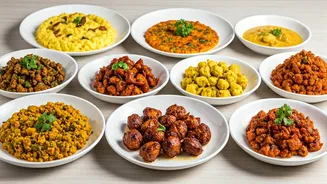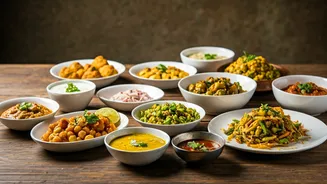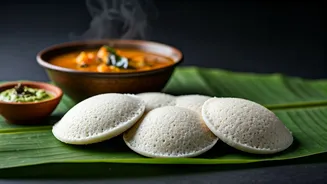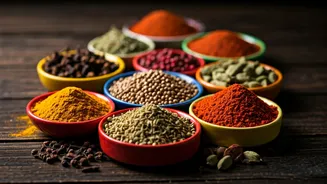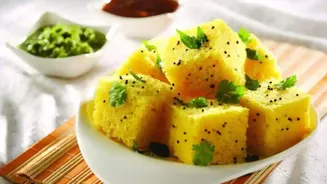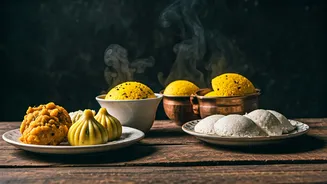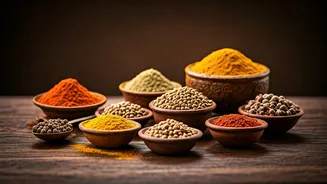Introduction to Gujarat
Gujarati cuisine is renowned for its unique blend of sweet, savory, and spicy flavors, often creating a delightful balance in every dish. The use of various
spices, lentils, vegetables, and grains gives this cuisine a distinctive character. Many Gujarati dishes also lean towards vegetarian options, making them a great choice for health-conscious individuals. Furthermore, the emphasis on using fresh, seasonal ingredients enhances both the taste and nutritional value of the meals. The cooking methods, often involving steaming, frying, or baking, contribute to the diverse textures and presentations. Gujaratis tend to enjoy a variety of dishes in one meal, offering a holistic dining experience, allowing one to taste different flavors in a single sitting. The use of ghee and oil in moderation provides richness without compromising health. It's a cuisine that celebrates family, community, and the joy of sharing food, making it an integral part of Gujarati culture.
Dhokla: The Starter
Dhokla, a steamed savory snack, is a staple in Gujarati cuisine. Made from fermented batter of rice and split chickpeas, the dish boasts a light and fluffy texture, making it a perfect appetizer or side dish. The fermentation process gives it a slightly tangy taste, enhanced by a tempering of mustard seeds, curry leaves, and green chilies, which is poured over the dhokla to infuse it with flavors. The dish is commonly served with a sweet and tangy chutney, adding a contrasting layer of flavor. Dhokla is not only delicious but also relatively healthy, as it is steamed rather than fried. It is a popular choice for breakfast, snacks, or even lunch and is loved across different age groups. The versatility of dhokla extends to its variations, such as the khaman dhokla, which is a faster version made primarily with gram flour, offering different textures and experiences for the eater.
Thepla: Flatbread Delight
Thepla, a soft and flavorful flatbread, is another essential element of Gujarati meals. Typically made with wheat flour, fenugreek leaves (methi), and spices, it offers a distinct taste and aroma. The addition of yogurt and spices, like turmeric and chili powder, creates a soft, slightly tangy dough that’s easy to roll out and cook. Thepla can be served for breakfast, lunch, or even as a traveling snack. Its durability and portability make it a convenient option. They are often eaten with various accompaniments, such as curd, pickles, or even a simple vegetable curry. The fenugreek leaves not only enhance the flavor but also add to the nutritional value, offering vitamins and minerals. Thepla is often packed during long journeys, symbolizing the adaptability and practicality of Gujarati cuisine, making it an integral part of family traditions and daily life.
Undhiyu: A Winter Treat
Undhiyu is a mixed vegetable dish, which is a must-have during the winter season. The name 'undhiyu' comes from the word 'undhu', meaning upside down in Gujarati, referring to the traditional cooking method where the dish is prepared in earthen pots, placed upside down in a fire pit. This slow-cooking method infuses the vegetables with a smoky flavor. The dish usually consists of a mix of seasonal vegetables like brinjal, potatoes, beans, and root vegetables, cooked with spices and a special masala made from herbs and greens. Undhiyu has a unique flavor profile, due to the blend of various vegetables and a variety of spices. It’s a labor-intensive dish, often made during special occasions and festivals. The combination of root vegetables and spices, make it a hearty and filling meal. Enjoying Undhiyu is a community affair, usually made and shared among families and friends, representing togetherness and culinary heritage.
Khandvi: Rolled Delights
Khandvi, another popular Gujarati snack, is made from a batter of gram flour and buttermilk, cooked to form thin, delicate rolls. The cooked batter is spread thinly and rolled with a tempering of mustard seeds, sesame seeds, and curry leaves. It's a savory treat that is both light and flavorful. The careful balance of spices ensures that each roll offers a burst of flavour. Khandvi is often garnished with fresh coriander and grated coconut, enhancing both the taste and visual appeal. The snack is versatile and can be served as an appetizer, a side dish, or even a part of a larger meal. It is a great example of the culinary creativity of Gujarati cuisine, as it showcases the transformation of simple ingredients into a delightful dish. The process of preparing Khandvi can be time-consuming, making it a special treat, and often prepared with love during festive occasions or gatherings, celebrating culinary skills.
Dal Dhokli: A Comfort Meal
Dal Dhokli is a wholesome, one-pot meal that combines the goodness of lentils (dal) with wheat flour dumplings (dhokli). The dhokli, or dough pieces, are cooked in a flavorful dal, absorbing the delicious spices and aromatic flavors. This dish is rich in protein from the lentils and provides carbohydrates from the dough. The dal usually consists of toor dal (split pigeon peas), seasoned with turmeric, cumin, and other spices. The dough is often flavored with spices and herbs as well. The slow cooking process allows the flavours to meld, creating a satisfying and comforting dish, perfect for a fulfilling meal. It's a great choice for those seeking a balance of nutrition and taste, making it a beloved dish across different generations. Dal Dhokli is easy to prepare and can be customized to suit individual preferences, making it a versatile and inclusive meal. The meal represents a perfect combination of flavour, nutrition and cultural significance.
Fafda-Jalebi: Sweet & Savory
Fafda-Jalebi is a classic Gujarati breakfast combination, enjoyed for its contrasting flavours and textures. Fafda is a crispy, savory snack made from gram flour, seasoned with carom seeds and other spices. It's deep-fried until golden brown, offering a satisfying crunch. Jalebi, on the other hand, is a sweet treat made by deep-frying fermented batter and then soaking it in sugar syrup. The hot, crispy fafda perfectly complements the sweet, syrupy jalebi, creating a unique taste experience. This combination is a staple during festivals and special occasions and is often enjoyed with a side of chutney. The contrasting textures of the crisp fafda and the soft, sugary jalebi make it a memorable treat. This combination reflects the Gujarati love for balancing different flavors, creating a harmonious and delightful eating experience. It is more than just food; it’s a cultural experience, representing the joyous spirit of Gujarati celebrations.
Khaman: Savory Cakes
Khaman is a popular savory cake in Gujarati cuisine, similar to Dhokla. It is typically made from a fermented batter of gram flour and is steamed to achieve a soft, spongy texture. Khaman is often tempered with mustard seeds, asafoetida, green chilies, and curry leaves, which infuses the cake with a flavorful aroma. It can be served as a snack, side dish, or even as a part of a larger meal. Khaman's versatility extends to its various forms, including the nylon khaman, known for its extra-soft texture. It is often garnished with coriander leaves and grated coconut. The lightness of Khaman makes it a favorite snack for all ages. It is a quick and easy recipe that has become very popular across different parts of the country. Khaman is often served with a sweet and tangy chutney, providing a delightful balance of flavors. The dish exemplifies the simple yet flavorful nature of Gujarati cuisine.
Shrikhand: Sweet Yogurt
Shrikhand is a sweet dessert made from strained yogurt (hung curd), sugar, and often flavored with cardamom and saffron. The yogurt is strained to remove the whey, resulting in a thick, creamy base. It is then sweetened and flavoured, and sometimes garnished with nuts like pistachios or almonds. Shrikhand has a rich and smooth texture, offering a luxurious mouthfeel. It is often served chilled, making it a refreshing dessert, especially during hot weather. This dessert is a staple during festivals and special occasions in Gujarat, symbolizing sweetness and prosperity. The simplicity of the ingredients belies the complexity of the flavors, making it a beloved treat across different age groups. It's a celebration of yogurt, transforming a simple ingredient into a sophisticated dessert. The preparation is simple but it requires patience to attain the right consistency. It perfectly captures the essence of Gujarat's culinary traditions.
